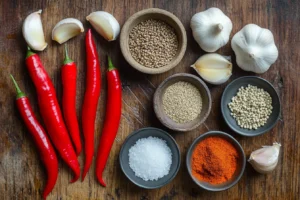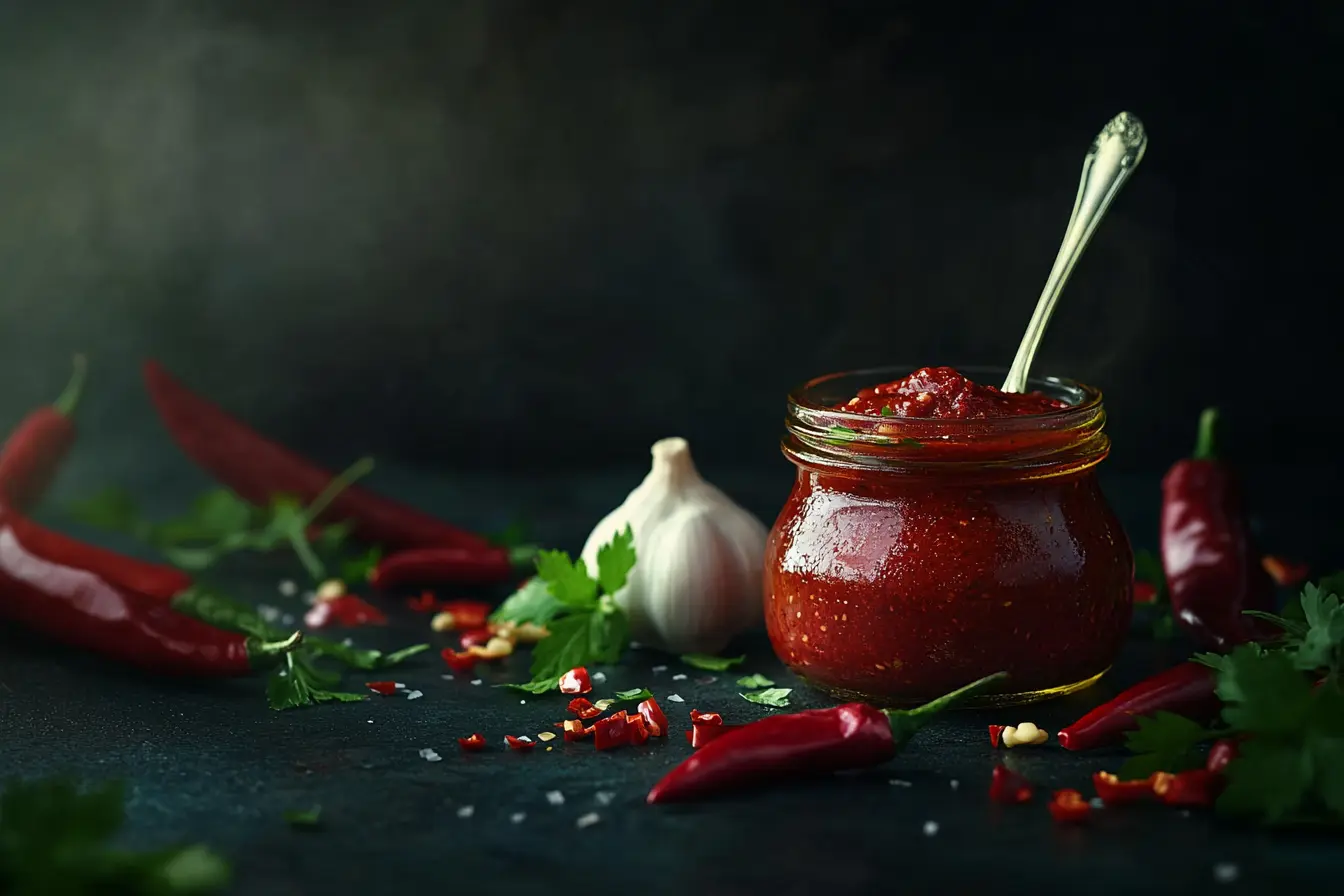Introduction
When it comes to adding a bold and flavorful kick to your dishes, nothing quite compares to the authentic taste of harissa paste. This fiery and aromatic condiment hails from North Africa, where it has been a cherished staple for generations. But it’s not just about heat; harissa offers a symphony of flavors, from earthy spices to a hint of smokiness. Whether you’re a culinary enthusiast or a beginner, this guide will walk you through everything, from its origins to making it at home, ensuring your dishes get that exotic twist.
What is Harissa Paste?
A North African Culinary Treasure
Harissa paste, rooted in Tunisian traditions, is a richly spiced chili paste made from sun-dried red chili peppers, garlic, olive oil, and an assortment of fragrant spices. Its bold flavor profile has made it indispensable in Middle Eastern and North African kitchens, where it is used in everything from soups to marinades.
Historical Roots of Harissa
The origins of harissa trace back to the 16th century, following the arrival of chili peppers in North Africa after the Columbian Exchange. Over time, local ingredients were married with these peppers, creating this beloved paste. Tunisia, in particular, took harissa to new heights, using it daily in their homes and cuisine.
Cultural Significance
In Tunisia, harissa is more than a condiment—it’s a source of pride and identity. Families often have unique recipes, passed down for generations. In 2022, UNESCO added harissa to its intangible cultural heritage list, recognizing its importance not only as a dish but also as a representation of Tunisian culture.
Why Make It At Home?
Store-bought harissa is convenient, but homemade versions let you customize the heat, texture, and flavor. Plus, it’s free from preservatives! With just a handful of ingredients and a bit of time, you can create a fresh and vibrant harissa paste that rivals anything off the shelf.
Ingredients and Preparation
Essential Ingredients for Harissa Paste
 Making harissa paste at home begins with understanding its fundamental ingredients. Each component brings a unique layer to the flavor profile, creating the perfect balance of heat, smokiness, and aromatic depth. Here’s what you’ll need:
Making harissa paste at home begins with understanding its fundamental ingredients. Each component brings a unique layer to the flavor profile, creating the perfect balance of heat, smokiness, and aromatic depth. Here’s what you’ll need:
- Red Chili Peppers: These are the heart and soul of harissa. Traditional recipes often use dried peppers like Baklouti or Guajillo, which impart an intense flavor and brilliant red color.
- Garlic: This aromatic ingredient adds a pungent undertone that perfectly complements the heat of the chilies.
- Olive Oil: Not only does it bind the ingredients together, but it also acts as a natural preservative.
- Spices: Cumin, coriander, and caraway seeds are typically toasted to release their aromatic oils before being added.
- Salt: A small but mighty addition to enhance and balance the flavors.
Optional Additions
While the traditional recipe is simple, many cooks like to personalize their harissa paste by adding ingredients such as:
- Tomatoes: For a milder, sweeter variation.
- Smoked Paprika: Enhances the smoky undertones.
- Lemon Juice: Adds brightness and acidity.
Step-by-Step Preparation
- Soak the Dried Chilies: Start by removing the seeds (if you prefer less heat) and soaking the chilies in warm water for about 20 minutes, or until soft.
- Roast and Toast: While the chilies soak, roast fresh red bell peppers until their skins blacken, then peel and deseed them. Toast the spices lightly in a dry pan to unlock their full flavor.
- Blend the Ingredients: In a food processor, combine the softened chilies, roasted peppers, garlic, toasted spices, and a drizzle of olive oil. Blend until smooth.
- Adjust the Consistency: Gradually add olive oil until you achieve your desired texture—thick for a paste or thinner for a spreadable sauce.
- Store Properly: Transfer the harissa to a sterilized jar and top it with a thin layer of olive oil. This keeps air out and helps preserve the paste for weeks in the refrigerator.
Variations of Harissa Paste
Regional Variations of Harissa Paste
Although harissa paste originated in Tunisia, variations across North Africa and the Middle East showcase the flexibility and adaptability of this iconic condiment. Each region brings its own twist, reflecting local tastes and ingredient availability.
- Tunisian Harissa: The original and most robust version, typically made with dried chilies and flavored with caraway and garlic. Tunisian harissa often has a slightly fermented note, thanks to the addition of lemon juice or preserved lemons.
- Moroccan Harissa: While still fiery, Moroccan harissa includes sweeter flavors, with the occasional addition of smoked or sweet peppers. It’s often used as a table condiment alongside tagines and couscous.
- Algerian Harissa: This version leans milder, with the addition of fresh tomatoes to balance the heat and create a slightly creamier texture.
Adjusting the Flavor to Suit Your Palate
Homemade harissa paste offers an incredible opportunity to tailor the flavor, heat, and texture to your preferences.
Milder Harissa
If you’re not a fan of too much spice, use a mix of sweet bell peppers and mild chilies. Removing the seeds and veins from the chili peppers also helps tone down the heat.
Smokier Notes
To add a smoky flavor, incorporate roasted red peppers or a touch of smoked paprika. This variation pairs beautifully with grilled meats.
Tangier Options
A splash of fresh lemon juice or a spoonful of preserved lemon puree can brighten the harissa paste, giving it a zesty edge.
Texture Adjustments
The consistency of harissa paste can vary widely based on personal preference or intended use:
- Thick Paste: Ideal for marinades or as a rub for meats.
- Smoother Sauce: Add more olive oil or water to create a pourable sauce, perfect for drizzling over roasted vegetables or salads.
Creative Variations
Experiment with different spices or add a touch of sweetness using honey or pomegranate molasses. While non-traditional, these additions can create a unique take on harissa.
Culinary Uses of Harissa Paste
How to Use Harissa Paste in Your Cooking
 The versatility of harissa paste makes it a culinary treasure in kitchens worldwide. Whether you’re spicing up a quick weeknight dinner or crafting an elaborate meal, this chili paste can add depth, flavor, and heat to countless dishes.
The versatility of harissa paste makes it a culinary treasure in kitchens worldwide. Whether you’re spicing up a quick weeknight dinner or crafting an elaborate meal, this chili paste can add depth, flavor, and heat to countless dishes.
As a Condiment
Harissa paste is perfect as a standalone condiment, offering bold flavors and a fiery kick.
- Spreads: Spread it over crusty bread or use it to elevate your sandwiches and wraps.
- Dips: Mix with plain yogurt or hummus for a creamy, spicy dip that pairs wonderfully with pita bread or veggie sticks.
In Cooking
Harissa paste shines as an ingredient in cooked dishes, adding richness and complexity to a variety of recipes.
Marinades and Rubs
Marinate chicken, lamb, or fish with harissa paste mixed with olive oil and a splash of lemon juice. The result? A smoky, spicy flavor that seeps into the protein.
Soups and Stews
Stirring a spoonful of harissa paste into your soups or stews adds an instant depth of flavor. It works especially well in lentil soups or chickpea stews.
Grain Dishes
Mix harissa paste into couscous, rice, or quinoa for a quick and flavorful side dish. Add raisins and toasted almonds for a Moroccan-inspired twist.
Creative Applications
For those looking to get inventive, harissa paste can be the star of some unexpected dishes.
- Egg Dishes: Add a dollop to scrambled eggs or swirl it into shakshuka for a rich and spicy breakfast.
- Vegetable Roasts: Toss vegetables like carrots, zucchini, or sweet potatoes in a harissa-olive oil mix before roasting for an irresistible flavor boost.
- Pasta Sauce: Incorporate harissa into tomato-based pasta sauces for a spicy twist on a classic.
Pairing Suggestions
Harissa pairs beautifully with cooling agents like yogurt or labneh, creating a balanced taste experience. It also complements dishes featuring citrus or honey, as these flavors help temper its spiciness.
Nutritional Information and Considerations
Understanding the Nutritional Profile of Harissa Paste
Harissa paste is not only a flavor enhancer but also a source of nutrients. Packed with vitamins, antioxidants, and healthy fats, it brings more to the table than just spice. Let’s break down its key nutritional aspects.
Calories and Macronutrients
A typical tablespoon of harissa paste contains:
- Calories: Approximately 37
- Fats: 3 grams (primarily healthy fats from olive oil)
- Carbohydrates: 2 grams
- Protein: Less than 1 gram
The minimal calorie content makes it a guilt-free way to add flavor to your dishes.
Rich in Vitamins and Minerals
Thanks to its chili pepper base, harissa is an excellent source of:
- Vitamin C: Essential for boosting immunity and skin health.
- Vitamin A: Supports eye health and immune function.
- Iron: Crucial for oxygen transport and energy production.
Health Benefits of Harissa Paste
The ingredients in harissa boast impressive health properties:
Anti-Inflammatory Effects
Capsaicin, the compound responsible for the heat in chili peppers, has been shown to reduce inflammation and even aid in pain relief.
Antioxidant Power
Garlic and the spices in harissa are loaded with antioxidants that help combat oxidative stress and promote overall well-being.
Heart Health
The olive oil in harissa provides monounsaturated fats that support cardiovascular health.
Dietary Considerations
Spice Sensitivity
For those sensitive to spicy foods, start with small amounts of harissa paste. Balancing it with yogurt or cream can help neutralize its heat.
Sodium Content
Since salt is a key ingredient, it’s important to use harissa sparingly if you’re on a low-sodium diet. Opt for homemade versions to control the salt levels.
Frequently Asked Questions (FAQs)
What is harissa paste made of?
Harissa paste is typically made with a blend of red chili peppers, garlic, olive oil, and toasted spices like cumin, coriander, and caraway seeds. Some recipes may also include lemon juice or preserved lemons to add a tangy kick.
How spicy is harissa paste?
The spiciness of harissa paste can vary depending on the type of chili peppers used and whether the seeds are included. If you prefer a milder version, you can reduce the quantity of chilies or remove their seeds. Alternatively, balancing it with yogurt or honey can mellow the heat while keeping the flavor intact.
How long does homemade harissa paste last?
When stored properly, homemade harissa paste can last up to a month. Be sure to refrigerate it in a sterilized jar, ensuring a thin layer of olive oil is added on top to seal in freshness and prevent spoilage.
Can I freeze harissa paste?
Yes! Freezing harissa paste is a fantastic way to make it last longer. Use an ice cube tray to portion the paste into small, convenient servings. Once frozen, transfer the cubes to a freezer-safe bag, where they’ll keep for up to six months.
Is harissa paste gluten-free?
Typically, harissa paste is gluten-free because its traditional ingredients are naturally free of gluten. However, it’s always wise to double-check store-bought versions for potential cross-contamination or added ingredients.
Can harissa paste be used for vegetarian dishes?
Absolutely! Harissa paste is a versatile ingredient that works wonderfully in vegetarian meals. Use it to spice up roasted vegetables, grain bowls, or even soups for a robust, smoky flavor.

